Mohd Maroof Siddiqui1 and Ruchin Jain2
1College of Engineering, Dhofar University, Sultanate of Oman, Oman.
2College of Engineering, RBCET, India.
Corresponding Author E-mail : maroofsiddiqui@yahoo.com
DOI : https://dx.doi.org/10.13005/bpj/2153
Abstract
This sleep disorder is reflected as the changes in the electrical activities and chemical activities in the brain that can be observed by capturing the brain signals and the images. In this research, Short Time-frequency analysis of Power Spectrum Density (STFAPSD) approach applied on Electroencephalogram (EEG) Signals for prediction of RBD sleep disorder. Collection of Electroencephalogram (EEG) of normal subjects & different type of sleep disordered subjects & application of signal processing on EEG data for development the algorithm for detection of sleep disorder and implementation in MATLAB.
Keywords
Analysis of EEG; Causes of Sleep Disorder; Filtering of EEG
Download this article as:| Copy the following to cite this article: Siddiqui M. M, Jain R. Prediction of REM (Rapid Eye Movement) Sleep Behaviour Disorder using EEG Signal applied EMG1 and EMG2 Channel. Biomed Pharmacol J 2021;14(1). |
| Copy the following to cite this URL: Siddiqui M. M, Jain R. Prediction of REM (Rapid Eye Movement) Sleep Behaviour Disorder using EEG Signal applied EMG1 and EMG2 Channel. Biomed Pharmacol J 2021;14(1). Available from: https://bit.ly/3qeXu9Wr |
Introduction
REM sleep was first described in 1953. This is a unique sleep phase observed specially in birds and mammals. This stage is characterized by random eye movements and lower muscular tone. A special pattern of brain waves are observed on EEG. These brain waves have a lower voltage value and faster frequency. These waves are similar to that of the normal awake state. The absolute inactivity of the voluntary muscles in the body and rapid eye movements are observed in REM sleep. The first phase of REM typically goes on around ten minutes. Later every REM stages gets longer, and the final one may last approximately for up to an hour. This results in faster heart rate and breathing [Charbonnier, 2011]. It causes dreams as the brain is more active in this stage. Children generally spend up to half of their entire sleep in the REM stage, whereas adults spend only one fifth of entire sleep in this stage.
Sleep Disorders, It’s Types and Causes of Sleep Disorders
A sleep disorder is a medicinal disorder of the sleep. It affects the physical, mental, emotional and social wellbeing of a person. Lack of sleep not only affects quality of sleep of a person but also create a negative impact on his energy towards work, emotional balance, and health. Sleep acts as an indicator of a person’s health. A person with good health experiences a quality sleep, while a person suffering from frequent sleeping problems may not experience a quality sleep resulting in poor or average mental or medical health. It is a general phenomenon that a minor loss of sleep can decrease your energy level, efficiency, ability to handle stress, swing off your mood, etc. Ignoring sleep problems and sleep disorders are a serious problem because they may cause a great damage in terms of accidents, poor job performance, relationship stress etc.
Sleep disorder is classified mainly into following categories:
Difficulty staying awake
Difficulty in sleeping
Abnormal behavior during sleep
Some people experience difficulty while they are awake & could not sleep like normal person. This type of sleeping disorder is called Hypersomnia [Braughton, 1968]. There are others who experience difficulty in sleeping; this type of sleeping disorder is known as Insomnia. People who experience both the above problems, that is, difficulty in sleeping as well as staying awake, normally suffers from Dyssomnias. Some people experience some abnormal sensations and behave abnormal during sleep; this type of sleep disorder is known as Parasomnias. This might be harmful to them as well as to their bed partners.
There are diverse psychological and physiological factors that may interfere with sleep. The main purpose of the subject measurement is to identify the contributing factors of disturbed sleep. Subject suffering from primary Insomnia show less diurnal sleepiness, higher heart rates, higher core body temperature and high metabolic activities. The three main identifiers of Insomnia are:
Sleep-onset delay
Early morning arousal
Sleep fragmentation.
DSM 5 Criteria for Insomnia [Diagnostic D.S.M.V, 2013]
The foremost dissatisfaction of quality and quantity of sleep may be related to any or all of the following problems:
Problem in the beginning of sleep.
Problem in maintaining sleep.
waking up early and not able to sleep again.
Dreaming is a mental experience that mind does when the body is at rest. The subject of REM Behavior Disorder (RBD) starts acting out their dreams. They physically start moving their limbs and sometimes even get up and start other activities related with waking. The subjects of RBD lacks of muscle paralysis, which make them to act out their dreams in a violent and dramatic manner when they are in the REM stage of sleep.
Diagnosis
RBD become worse over time and is unsafe for both selves and for a bed partner. It can be diagnosed by the help of sleep studies like Polysomnography. In polysomnography, the subject is carefully monitored throughout the night. Readings of sleep, brain activity, muscular activity and other physiological measurements are taken into consideration.
Clinical interviews are now conducted by doctors in order to help diagnose this disease. These interviews, contain questions that one generic but vital about patient timing of sleep, habits, medications, alcohol intakes, routines, etc. Sometimes interview with bed associates is also conducted in order to help the correct diagnosis.
Analysis of Eeg Signals
The sleep events are clipped off from the EEG signal recording of whole night, each clipped signal contain single stage of sleep. Figure 1 shows various signals of EEG recording data.
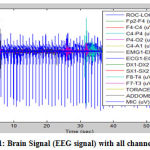 |
Figure 1: Brain Signal (EEG signal) with all channels. |
Extraction of Channel
Figure 1 shows the EEG signal which has multiple channels (Fp2 –F4, C4-A1, ROC-LOC and others) of a single stage of sleep REM. Extracted different channels from EEG data EMG1-EMG2 channels are shown in figure 2.
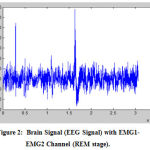 |
Figure 2: Brain Signal (EEG Signal) with EMG1-EMG2 Channel (REM stage). |
Filtering of the Signal
Clipped signal is preprocessed and then conceded through the Hanning window low pass filter for removing the high-frequency above 25 Hz. The filter used is an FIR filter of order 200 with a cutoff frequency of 25 Hz Figure 3 shows filtered EEG signals for the EMG1-EMG2.
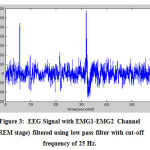 |
Figure 3: EEG Signal with EMG1-EMG2 Channel (REM stage) filtered using low pass filter with cut-off frequency of 25 Hz. |
Comparison between Filtered and Non-Filtered Signal
Figure 4 gives a comparison between zero-phase filtering and conventional filtering.
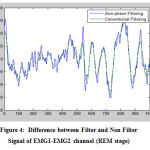 |
Figure 4: Difference between Filter and Non Filter Signal of EMG1-EMG2 channel (REM stage) |
Normalized Power Comparison Between Normal Person and Rbd Patient
Table 1 shows the normalized power of Beta wave for the normal subject and the RBD patient. The analysis is done for EMG1-EMG2 channel and stage REM. It is observed that normalized power of Beta wave for
Normal subject lies between 0.0020 and 0.0089
RBD patient lies between 0.053 and 0.0791
So normalized power of Beta wave in case of the normal subject is low and for RBD patient is very high.
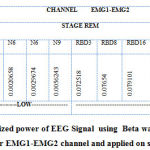 |
Table 1: The Normalized power of EEG Signal using Beta wave of normal subject and RBD patient for EMG1-EMG2 channel and applied on sleep stage of REM. |
Conclusion
Normalized Power of normal subjects with no symptoms of sleep disorders has been calculated (range define) and then compared with pathological cases. . The result helps us to easily differentiate between sleep disorder patients and a normal person, on the basis normalized power. This method will replace the graphical method of detection that is in contemporary use. This work can be implemented as an economically better alternative, reducing the involvement of a full-time expert for data analysis, which can be done by any computer literate individual. Computer literacy is the only compulsory prerequisite for the ability to execute this task.
References
- Tzallas, A. T., Tsipouras, M. G., & Fotiadis, D. I. (2007, August). In Engineering in Medicine and Biology Society, 2007. EMBS 2007. 29th Annual International Conference of the IEEE (pp. 3-6). IEEE.
- Tzallas, A. T., Tsipouras, M. G., & Fotiadis, D. I. (2009). Epileptic seizure detectionin EEGs using time–frequency analysis. IEEE transactions on information technology in biomedicine, 13(5), 703-710
CrossRef - Parhi, K. K., & Ayinala, M. (2014). IEEE Transactions on Circuits and Systems I:Regular Papers, 61(1), 172-182.
CrossRef - Siddiqui M. M, Srivastava G, Saeed S. H. Diagnosis of Nocturnal Frontal Lobe Epilepsy (NFLE) Sleep Disorder Using Short Time Frequency Analysis of PSD Approach Applied on EEG Signal. BiomedPharmacol J 2016;9(1)
CrossRef - Siddiqui, Mohd Maroof, et al. “Detection of rapid eye movement behaviour disorder using short time frequency analysis of PSD approach applied on EEG signal (ROC-LOC).”Biomedical Research 26.3(2015): 587- 593.
- Agarwal, R., Takeuchi, T., Laroche, S., & Gotman, J. (2005). IEEE Transactions on biomedical engineering, 52(8), 1390-139
CrossRef - Diykh, M., Li, Y., & Wen, P. (2016). IEEE Transactions on Neural Systems and Rehabilitation Engineering, 24 (11), 1159-1168.
CrossRef - Malinowska, Urszula, et al. “Micro-and macrostructure of sleep EEG.”IEEE engineering in medicine and biology magazine 4 (2006).
CrossRef - Khandoker, Ahsan H., Marimuthu Palaniswami, and Chandan K. Karmakar. “Support vector machines for automated recognition of obstructive sleep apnea syndrome from ECG recordings.” IEEE transactions on information technology in biomedicine 1 (2009).
CrossRef - Henelius, Andreas, Jussi Korpela, and Minna Huotilainen. “Individualising EEG frequency bands for sleep deprivation studies.”Engineering in Medicine and Biology Society, EMBC, 2011 Annual International Conference of the IEEE, (2011).
CrossRef - Quine, L. “Sleep problems in children with mental handicap.”Journal of Intellectual Disability Research4 (1991).
CrossRef - Stores, Gregory. “Children’s sleep disorders: modern approaches, developmental effects, and children at special risk.”Developmental Medicine & Child Neurology8 (1999).
CrossRef - Liu, Derong, Zhongyu Pang, and Stephen R. Lloyd. “A neural network method for detection of obstructive sleep apnea and narcolepsy based on pupil size and EEG.”IEEE Transactions on Neural Networks2 (2008).
CrossRef - Iasemidis, Leon D. “Epileptic seizure prediction and control.”IEEE Transactions on Biomedical Engineering5 (2003).
CrossRef - Siddiqui M. M, Srivastava G, Saeed S. H. Detection of Sleep Disorder Breathing (SDB) Using Short Time Frequency Analysis of PSD Approach Applied on EEG Signal. Biomed Pharmacol J 2016;9(1)
CrossRef - Siddiqui, Mohd Maroof, et al. “EEG Signals Play Major Role to diagnose Sleep Disorder.” InternationalJournal of Electronics and Computer Science Engineering (IJECSE) 2.2 (2013): 503-505.
- Siddiqui, Mohd Maroof, et al. “Detection of Periodic Limb Movement with the Help of Short Time Frequency Analysis of PSD Applied on EEG Signals.” Extraction 4.11 (2015)
- Siddiqui, Mohd Maroof, et al, “Diagnosis of narcolepsy sleep disorder for different stagesof sleep using Short Time Frequency analysis of PSD approach applied on EEG signal,” 2016 International Conference on Computational Techniques in Information and Communication Technologies (ICCTICT),New Delhi, 2016, pp. 500-508.
CrossRef - Siddiqui, Mohd Maroof, Geetika Srivastava, Syed Hasan Saeed, et al. “Detection of Rapid Eye Movement Behaviour Sleep Disorder using Time and Frequency Analysis of EEG Signal Applied on C4-A1 Channel” Communication and Power Engineering.Berlin, Boston: De Gruyter, 2016. 310-326
CrossRef - iddiqui MM, et al. Diagnosis of insomnia sleep disorder using short time frequency analysis of PSD approach applied on EEG signal using channel ROC-LOC. Sleep Science (2016)
CrossRef - Goldberger, A. L., Amaral, L. A., Glass, L., Hausdorff, J. M., Ivanov, P. C., Mark, R. G., … & Stanley, H. E. (2000). Physiobank, physiotoolkit, and physionet. Circulation, 101(23), e215-e220
CrossRef - Becq, G., Charbonnier, S., Chapotot, F., Buguet, A., Bourdon, L., & Baconnier, P. (2005). Comparison between five classifiers for automatic scoring of human sleep recordings. Classification and Clustering for Knowledge Discovery, 113-127.
CrossRef - Charbonnier, S., Zoubek, L., Lesecq, S., & Chapotot, F. (2011). Self-evaluated automatic classifier as a decision-support tool for sleep/wake staging. Computers in biology and medicine, 41(6), 380-389.
CrossRef - Cipani, E., & Schock, K. M. (2010). Functional behavioral assessment, diagnosis, and treatment: A complete system for education and mental health settings. Springer Publishing Company.
- Siddiqui M. M, Srivastava G, Saeed S. H.(2017).Alzheimer: A Neurological Disorder. Research and Reviews: Journal of Medicine. 7(1)
- Diagnostic, D. S. M. V. (2013). statistical manual of mental health disorders: DSM-5. 5.
- Siddiqui Mohd Maroof. (2019) Diagnosis of Sleep Disorders using EEG Signal LAP LAMBERT Academic Publishing.








